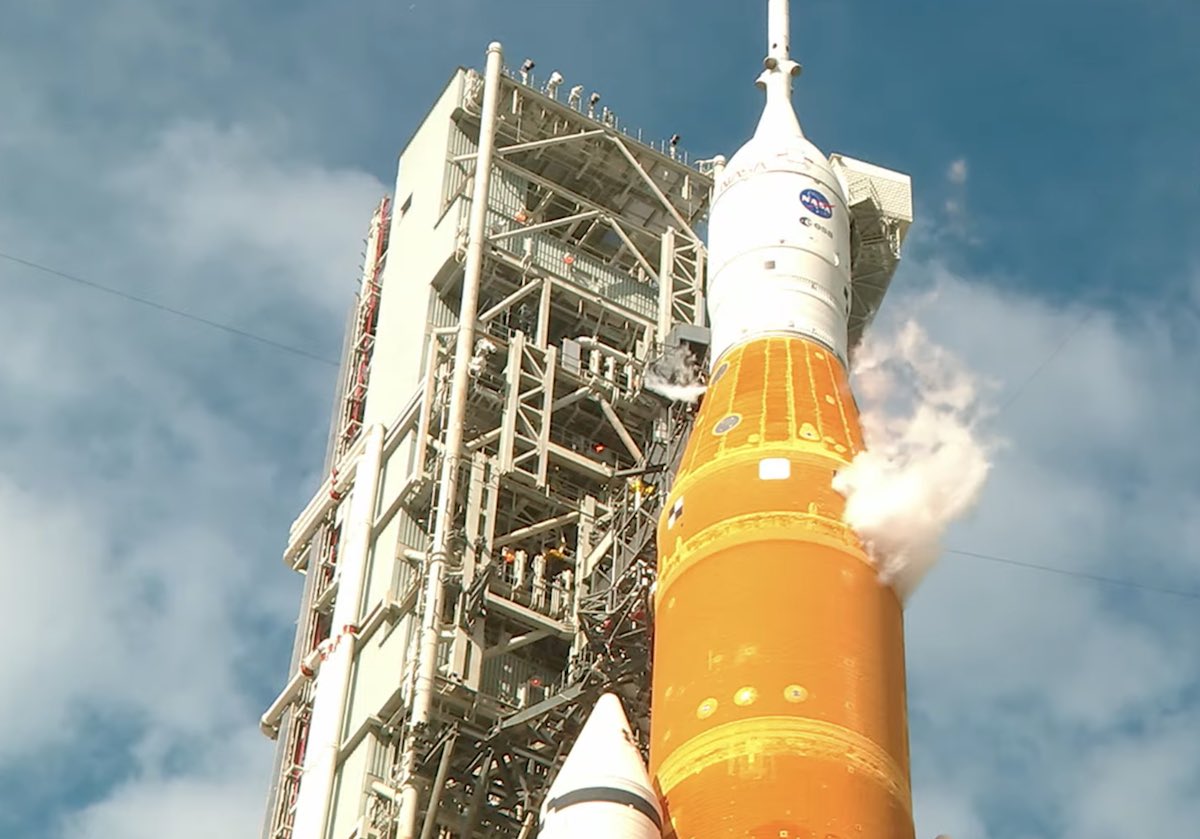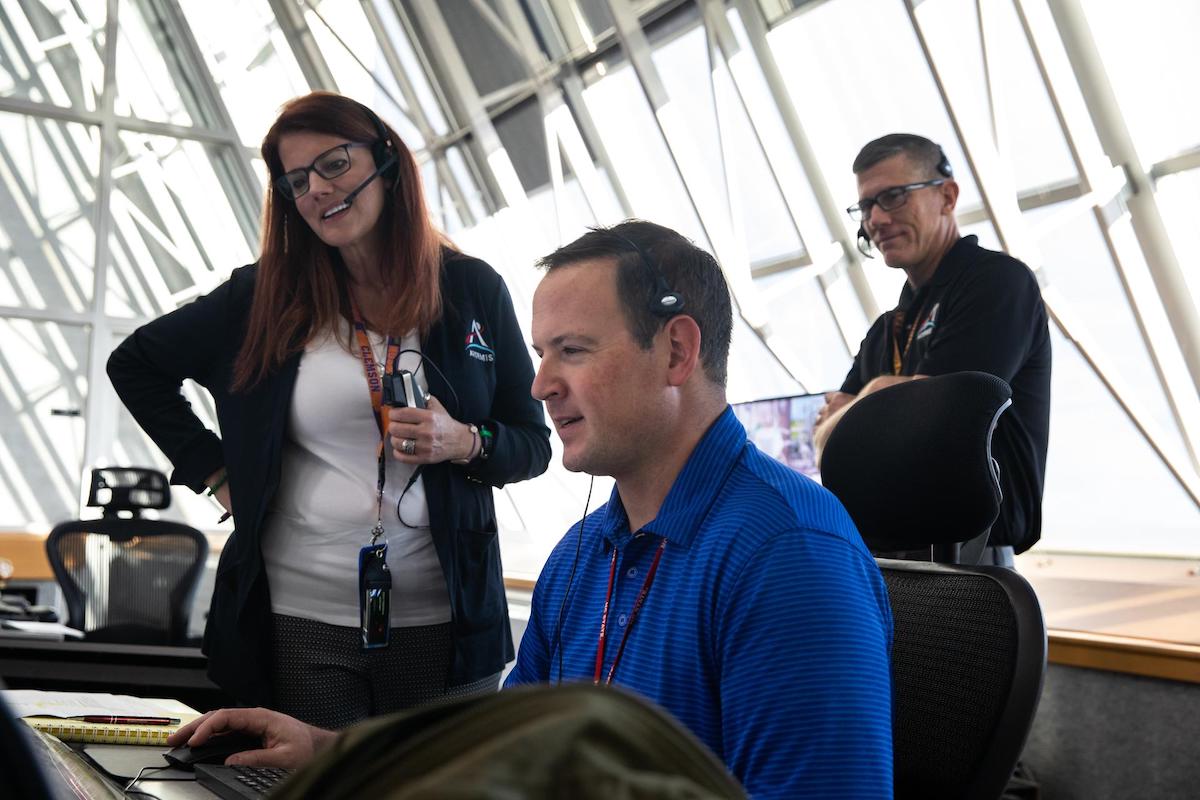
Engineers filled up the Artemis 1 moon rocket with more than 750,000 gallons of super-cold propellants in a tanking test Wednesday at Kennedy Space Center after troubleshooting a persistent hydrogen leak. NASA’s launch director said she was “extremely encouraged” by the test, but officials have not yet committed to another attempt to launch the uncrewed test flight to the moon at the next opportunity Sept. 27.
“We’ll go take a look at the data,” launch director Charlie-Blackwell-Thompson said. “I don’t like to get ahead of the data, so I’d like the team to have an opportunity to go look at it, to see if there are changes we need to make to our loading procedure, our timelines, or if we’re good as is.”
The Space Launch System, the most powerful rocket ever developed by NASA, was grounded after a Sept. 3 launch attempt due to a large hydrogen leak. The leak was detected in the tail service mast umbilical, the connection between the rocket’s core stage and the mobile launch platform. A previous launch attempt Aug. 29 was scrubbed by sensor data indicating one of the rocket’s four core stage engines was not being properly thermally conditioned for launch, but NASA later determined that data came from bad instrumentation.
Since the Sept. 3 launch attempt, technicians at the launch pad replaced seals in 8-inch and 4-inch quick-disconnect fittings where hydrogen fuel flows between the rocket and the launch platform. NASA managers decided to perform a cryogenic tanking test on the rocket before moving forward with another launch attempt.
The launch team modified the tanking procedures for the cryogenic loading test Wednesday. They developed a “kinder and gentler” way of filling the propellant tanks, using lower pressures and allowing more time for propellant lines to chill down to super-cold temperatures. The changes extended the tanking timeline by about 30 minutes, officials said.
“We had a new loading procedure that we had in place,” Blackwell-Thompson said. “It was very purposeful in the way in which we through the loading operations. We called it kinder, gentler.”
The cryogenic loading test Wednesday exposed the leaky umbilical connection to super-cold temperatures as liquid hydrogen flowed into the rocket. The liquid hydrogen is chilled to minus 423 degrees Fahrenheit, while the liquid oxygen on-board the moon rocket is kept at minus 298 degrees.
But the Artemis launch team again detected a leak in the hydrogen umbilical connection early Wednesday, with hydrogen concentrations spiking to 7% around the quick-disconnect fitting as engineers ramped up the flow rate into the core stage tank, nearly twice the allowable limit of 4%.
Engineers stopped the hydrogen flow into the rocket to allow the line to warm up, then resumed loading fuel at lower pressure. The connection held firm on the second fueling attempt, with hydrogen concentrations remaining below 1% for most of the tanking test.
“When we reinitiated flow, we began to raise the pressures back up to get back into a fast fill configuration, and we were successful in that,” Blackwell-Thompson said Wednesday afternoon in an interview aired on NASA TV. “So we did not see the same leak signature, which was wonderful. It allowed us to go through our enter loading profile all the way to core stage replenish.”
Derrol Nail, a NASA spokesperson providing commentary from the launch control center, said the hydrogen briefly spiked to 3.4% as the launch team began routing super-cold liquid hydrogen through the core stage engines for thermal conditioning.
“One of the pieces of data very encouraging to me was as we raised the pressure, we actually saw the leak go down,” Blackwell-Thompson said. “This is a pressure-assisted seal, so that was very encouraging and then we saw the leak rate really taper off.”
Another hydrogen quick-disconnect fitting, in a smaller 4-inch bleed line, also leaked later in the tanking test as engineers pressurized the core stage liquid hydrogen tank, sending concentrations as high as 5%, according to Nail.
Blackwell-Thompson said the launch team was disappointed when they initially saw the leak at the start of tanking Wednesday.
“I think that’s normal, but what they did is they went and looked at what are our contingency procedures … We were successful in managing our way through it,” she said.
“We also loaded the upper stage today as well, went through our kick start bleed, went through our pre-press test, so all our objectives that we set out to do we were able to accomplish today,” Blackwell-Thompson said.

The shape and size of seals and gaskets can change when exposed to super-cold temperatures, creating a leak path not easily detectable at ambient temperatures. A molecule of liquid hydrogen, created by bonding two hydrogen atoms together, is one of the tiniest known in the universe, and leak through gaps impermeable to other molecules.
Hydrogen leaks have been a persistent problem during the Artemis 1 launch campaign as NASA prepares for the first test flight of the SLS moon rocket, a 322-foot-tall (98-meter) vehicle that’s cost more than $20 billion to date and has taken a decade to develop.
The SLS moon rocket is a centerpiece in NASA’s plans to return astronauts to the moon for the first time since 1972. The unpiloted Artemis 1 test flight will send NASA’s human-rated Orion spacecraft on a shakedown cruise to orbit the moon and return to Earth. It will be be followed by Artemis 2, set to include a team of four astronauts launching on the second flight of the Space Launch System and Orion spacecraft.
Future Artemis missions will build a mini-space station in orbit around the moon. NASA has a multibillion-contract with SpaceX to use its next-generation Starship rocket as a moon lander to ferry astronauts between the Orion capsule and the lunar surface.
But before those plans can get off the ground, NASA must complete the first demonstration launch of the SLS moon rocket.
The SLS moon rocket’s core stage contains 537,000 gallons of liquid hydrogen fuel and 196,000 gallons of super-cold liquid oxygen as an oxidizer. The same propellants power the SLS upper stage, with much smaller tanks. All four propellant tanks were loaded in the Sept. 21 tanking test, which ended Wednesday afternoon about an hour-and-a-half behind schedule, primarily due to delays caused by the hydrogen leak detected early in the tanking timeline Wednesday morning.
If NASA decides to move forward with another Artemis 1 launch attempt, the next opportunity is next Tuesday, Sept. 27, when a 70-minute window is available opening at 11:37 a.m. EDT (1537 GMT). A backup launch opportunity is tentatively set for Oct. 2. The current launch period closes Oct. 4, when the moon’s position in its orbit around Earth would make the mission profile impossible. The next launch period opens Oct. 17 and runs for two weeks, followed by another series of launch dates available beginning Nov. 12.
The hydrogen leak issue is not the only concern facing NASA’s Artemis launch team.
The space agency also continues to work with the U.S. Space Force’s Eastern Range on a request to extend the range’s certification of batteries on the SLS moon rocket’s flight termination system, which would destroy the launcher if it veered off course after liftoff. The range must approve the battery certification — initially 20 days, then increased to 25 days and now would need to cover at least 45 days — in order for NASA to proceed with attempts in late September and early October.
If the range doesn’t approve the battery certification extension, NASA will need to roll the SLS moon rocket back to the Vehicle Assembly Building, pushing the Artemis 1 launch date into the second half of October or November.
Email the author.
Follow Stephen Clark on Twitter: @StephenClark1.
from Spaceflight Now https://ift.tt/loWbG7Q
via World Space Info







0 comments:
Post a Comment